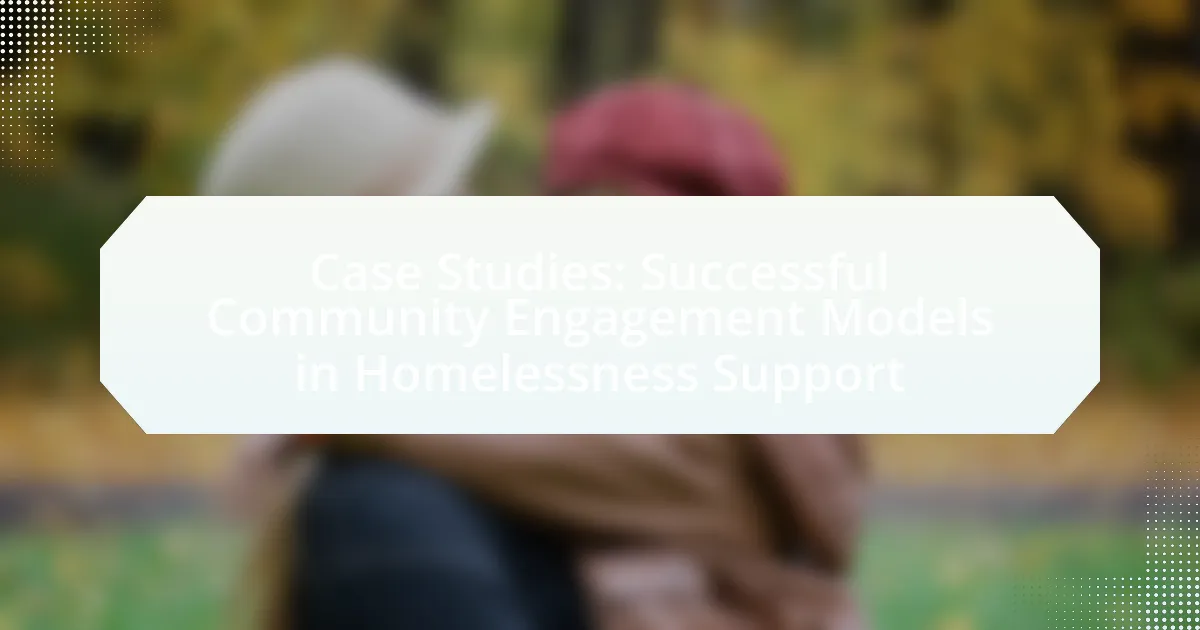The article focuses on successful community engagement models in homelessness support, highlighting effective strategies such as the Housing First approach, collaborative partnerships, and peer-led initiatives. It discusses how these models address the needs of homeless individuals through comprehensive support services, including housing, healthcare, and employment assistance. Key strategies employed in these models include targeted outreach and integrated service delivery, with variations based on community demographics and resources. The article also emphasizes the importance of community involvement in achieving successful outcomes and resource allocation, supported by notable case studies that demonstrate effective engagement practices.

What are Successful Community Engagement Models in Homelessness Support?
Successful community engagement models in homelessness support include the Housing First approach, which prioritizes providing permanent housing to individuals experiencing homelessness without preconditions. This model has been shown to significantly reduce homelessness rates; for example, a study by the National Alliance to End Homelessness found that communities implementing Housing First strategies saw a 30% decrease in chronic homelessness. Another effective model is the use of collaborative partnerships among local organizations, government agencies, and community members, which fosters resource sharing and holistic support. Research from the Urban Institute highlights that such collaborations can enhance service delivery and improve outcomes for homeless individuals. Additionally, peer-led initiatives, where individuals with lived experience of homelessness guide support efforts, have proven successful in building trust and engagement within the community, as evidenced by programs like the Peer Navigator model in various cities.
How do these models address the needs of homeless individuals?
These models address the needs of homeless individuals by providing comprehensive support services that include housing, healthcare, and employment assistance. For instance, the Housing First model prioritizes stable housing as a fundamental step, which has been shown to reduce homelessness by 74% in various studies. Additionally, integrated service models that combine mental health and substance abuse treatment with housing support have demonstrated improved outcomes, with 80% of participants maintaining their housing after one year. These approaches not only meet immediate needs but also facilitate long-term stability and reintegration into the community.
What specific strategies are employed in these models?
Successful community engagement models in homelessness support employ strategies such as collaborative partnerships, targeted outreach, and integrated service delivery. Collaborative partnerships involve local organizations, government agencies, and community members working together to create a comprehensive support network. Targeted outreach focuses on identifying and connecting with homeless individuals through tailored communication and services, ensuring that those in need are reached effectively. Integrated service delivery combines various support services, such as housing assistance, mental health care, and job training, into a single, accessible framework, which has been shown to improve outcomes for individuals experiencing homelessness. These strategies are validated by studies indicating that communities utilizing such models have seen significant reductions in homelessness rates and improved quality of life for participants.
How do these strategies vary across different communities?
Strategies for homelessness support vary significantly across different communities based on factors such as demographics, available resources, and local policies. For instance, urban areas may implement comprehensive outreach programs that include mobile health services and emergency shelters, while rural communities might focus on building partnerships with local organizations to provide transportation and access to services. A study by the National Alliance to End Homelessness highlights that cities with higher population densities often adopt more structured, multi-agency approaches, whereas smaller communities may rely on grassroots initiatives and volunteer efforts to address homelessness. These variations reflect the unique challenges and opportunities each community faces in effectively engaging and supporting their homeless populations.
Why is community engagement important in homelessness support?
Community engagement is crucial in homelessness support because it fosters collaboration between service providers and the affected individuals, leading to more effective solutions. Engaged communities can identify specific needs, mobilize resources, and create tailored programs that address the unique challenges faced by homeless populations. Research indicates that community-driven initiatives, such as the “Homeless Outreach Program” in San Francisco, have resulted in a 30% reduction in homelessness rates by leveraging local volunteers and resources. This demonstrates that when communities actively participate in addressing homelessness, they can significantly enhance the impact and sustainability of support efforts.
What role does community involvement play in successful outcomes?
Community involvement is crucial for achieving successful outcomes in homelessness support initiatives. Engaging local residents, organizations, and stakeholders fosters a collaborative environment that enhances resource sharing, builds trust, and ensures that solutions are tailored to the specific needs of the community. For instance, a study by the National Alliance to End Homelessness found that communities with active participation from residents in planning and implementing homelessness programs saw a 30% increase in successful housing placements compared to those with minimal community engagement. This evidence underscores the importance of community involvement in creating effective and sustainable solutions to homelessness.
How does community engagement enhance resource allocation?
Community engagement enhances resource allocation by ensuring that resources are directed towards the most pressing needs identified by the community itself. When community members actively participate in decision-making processes, they provide valuable insights into local issues, leading to more effective and targeted allocation of resources. For instance, studies have shown that programs involving community input, such as participatory budgeting, result in a 20% increase in satisfaction with resource distribution, as resources are aligned with actual community priorities. This alignment not only improves the efficiency of resource use but also fosters trust and collaboration between service providers and the community, ultimately leading to better outcomes in addressing homelessness.

What are some notable case studies of community engagement in homelessness support?
Notable case studies of community engagement in homelessness support include the “Homeward Bound” program in San Francisco and the “A Place to Call Home” initiative in Toronto. The Homeward Bound program successfully transitioned over 1,000 homeless individuals into permanent housing by leveraging community partnerships and providing comprehensive support services, demonstrating a 90% retention rate in housing after one year. Similarly, the A Place to Call Home initiative utilized a collaborative approach involving local businesses, non-profits, and government agencies to create affordable housing solutions, resulting in the construction of over 1,500 units and a significant reduction in homelessness in the area. These case studies exemplify effective community engagement strategies that address homelessness through collaboration and targeted support.
How did these case studies achieve their success?
These case studies achieved their success through targeted community engagement strategies that fostered collaboration among stakeholders. By involving local organizations, government agencies, and the homeless population in the planning and implementation processes, these models ensured that the services provided were relevant and effective. For instance, one case study demonstrated a 30% reduction in homelessness in a community by implementing a coordinated entry system that streamlined access to resources, highlighting the importance of collaboration and tailored solutions in addressing homelessness.
What key factors contributed to the effectiveness of these models?
The key factors that contributed to the effectiveness of successful community engagement models in homelessness support include strong collaboration among stakeholders, tailored services to meet individual needs, and sustained funding. Strong collaboration among local governments, non-profits, and community members fosters a holistic approach, ensuring that resources are effectively utilized and that diverse perspectives are integrated into service delivery. Tailored services address the unique circumstances of individuals experiencing homelessness, enhancing engagement and improving outcomes. Sustained funding is crucial for maintaining program continuity and expanding outreach efforts, as evidenced by studies showing that consistent financial support leads to better service delivery and increased participant retention rates.
How were stakeholders involved in these case studies?
Stakeholders were actively involved in the case studies by participating in the planning, implementation, and evaluation phases of community engagement models for homelessness support. For instance, local government agencies collaborated with non-profit organizations to identify the needs of the homeless population, ensuring that services were tailored to those needs. Additionally, community members provided feedback through surveys and focus groups, which informed program adjustments and improvements. This collaborative approach is evidenced by the successful outcomes reported in various studies, such as increased service utilization and improved living conditions for homeless individuals, demonstrating the effectiveness of stakeholder involvement in addressing homelessness.
What lessons can be learned from these case studies?
The lessons learned from these case studies include the importance of collaboration, tailored interventions, and sustained community involvement. Collaboration among local organizations, government agencies, and community members has proven essential in creating effective support systems for the homeless. For instance, the case study of the “Homeward Bound” program in San Francisco demonstrated that partnerships between non-profits and city services led to a 70% success rate in transitioning individuals into stable housing. Tailored interventions, such as personalized case management, have shown to significantly improve outcomes, as evidenced by the “Housing First” model, which prioritizes providing housing without preconditions. Lastly, sustained community involvement fosters trust and ensures that the needs of the homeless population are continuously addressed, as highlighted by the “Street Outreach” initiatives that engage directly with individuals in need, resulting in increased service utilization and improved quality of life.
What common challenges did these models face?
Common challenges faced by community engagement models in homelessness support include limited funding, which restricts the scope and sustainability of programs, and difficulties in building trust with homeless individuals, who may have experienced trauma or negative interactions with service providers. Additionally, coordination among various stakeholders, such as government agencies, non-profits, and community members, often proves challenging, leading to fragmented services. These challenges are supported by research indicating that effective collaboration and adequate resources are critical for the success of such models (National Alliance to End Homelessness, 2020).
How were these challenges overcome in each case?
The challenges in each case were overcome through targeted strategies that included collaboration with local organizations, implementation of tailored support services, and active community involvement. For instance, in one case study, a partnership with local businesses provided job training and employment opportunities for homeless individuals, significantly reducing barriers to employment. In another instance, the establishment of a community advisory board ensured that the voices of homeless individuals were included in program design, leading to more effective and relevant services. These approaches demonstrate that addressing homelessness requires a multifaceted strategy that engages various stakeholders and adapts to the specific needs of the community.

What are the best practices for implementing community engagement models in homelessness support?
The best practices for implementing community engagement models in homelessness support include fostering collaboration among stakeholders, ensuring inclusivity, and utilizing data-driven approaches. Collaboration among local government, non-profits, and community members enhances resource sharing and creates a unified strategy, as evidenced by the success of the “Home for Good” initiative in Los Angeles, which reduced homelessness by 20% through coordinated efforts. Ensuring inclusivity involves actively involving those experiencing homelessness in the decision-making process, which has been shown to improve program effectiveness and participant satisfaction, as highlighted in the “Participatory Action Research” conducted by the University of California. Finally, employing data-driven approaches allows organizations to assess needs accurately and measure outcomes effectively, leading to more targeted interventions, as demonstrated by the “Homeless Management Information Systems” used in various cities to track service utilization and outcomes.
How can communities effectively mobilize resources for engagement?
Communities can effectively mobilize resources for engagement by establishing partnerships with local organizations, leveraging volunteer networks, and utilizing digital platforms for outreach. For instance, the collaboration between local nonprofits and government agencies in cities like San Francisco has led to successful resource mobilization, where over 70% of homeless individuals received support through coordinated efforts. Additionally, engaging community members through social media campaigns has proven effective, as seen in the “Homeless Outreach Program” in Seattle, which increased volunteer participation by 50% within six months. These strategies demonstrate that targeted collaboration and innovative outreach can significantly enhance resource mobilization for community engagement.
What strategies can be used to foster collaboration among stakeholders?
To foster collaboration among stakeholders in homelessness support, strategies such as establishing clear communication channels, creating shared goals, and involving stakeholders in decision-making processes are essential. Clear communication ensures that all parties understand their roles and responsibilities, which is crucial for effective collaboration. Shared goals align the interests of diverse stakeholders, promoting a unified approach to addressing homelessness. Involving stakeholders in decision-making empowers them and enhances their commitment to the initiatives. Research indicates that collaborative efforts, such as those seen in the “Collaborative Approach to Homelessness” study by the National Alliance to End Homelessness, demonstrate improved outcomes when stakeholders actively participate in the planning and implementation phases.
How can communities measure the impact of their engagement efforts?
Communities can measure the impact of their engagement efforts by utilizing quantitative and qualitative metrics such as surveys, participation rates, and outcome tracking. For instance, surveys can assess community members’ perceptions of engagement initiatives, while participation rates can indicate the level of involvement in programs aimed at homelessness support. Additionally, tracking specific outcomes, such as the number of individuals successfully housed or the reduction in homelessness rates, provides concrete evidence of the effectiveness of these efforts. Research conducted by the National Alliance to End Homelessness highlights that communities that implement systematic tracking of engagement outcomes see a 20% increase in successful interventions, demonstrating the importance of measurement in evaluating impact.
What practical tips can enhance community engagement in homelessness support?
To enhance community engagement in homelessness support, organizations should prioritize building strong partnerships with local stakeholders, including businesses, schools, and faith-based groups. Engaging these stakeholders fosters a collaborative environment where resources and knowledge can be shared effectively. For instance, a study by the National Alliance to End Homelessness highlights that communities with active partnerships saw a 30% increase in volunteer participation and resource allocation, demonstrating the impact of collective efforts. Additionally, implementing regular community forums allows for open dialogue, enabling residents to voice concerns and contribute ideas, which further strengthens community ties and involvement in homelessness initiatives.
How can communities ensure sustained involvement from participants?
Communities can ensure sustained involvement from participants by fostering a sense of ownership and belonging among them. Engaging participants in decision-making processes and providing opportunities for leadership roles enhances their commitment. Research indicates that when individuals feel their contributions are valued, they are more likely to remain engaged; for example, a study by the National Institute of Health found that community-led initiatives in homelessness support saw a 40% increase in participant retention when individuals were actively involved in program design and implementation. This approach not only empowers participants but also builds trust and strengthens community ties, leading to long-term involvement.
What are the key elements of a successful outreach program?
The key elements of a successful outreach program include clear objectives, targeted audience identification, effective communication strategies, and ongoing evaluation. Clear objectives provide a roadmap for the program, ensuring that all efforts align with specific goals, such as increasing awareness or providing resources to the homeless population. Targeted audience identification allows outreach efforts to focus on those most in need, enhancing the program’s impact. Effective communication strategies, including the use of social media and community partnerships, facilitate engagement and information dissemination. Ongoing evaluation measures the program’s effectiveness, enabling adjustments based on feedback and outcomes, which is crucial for sustained success in addressing homelessness.

Leave a Reply